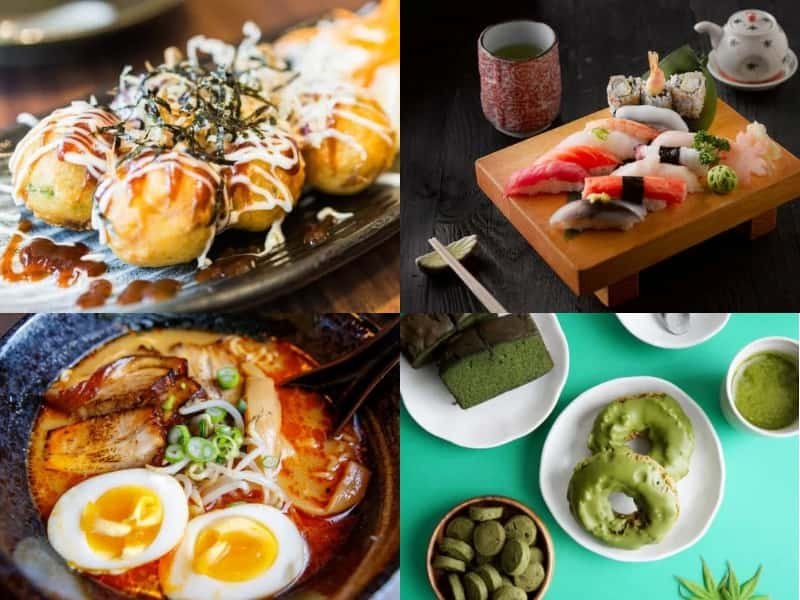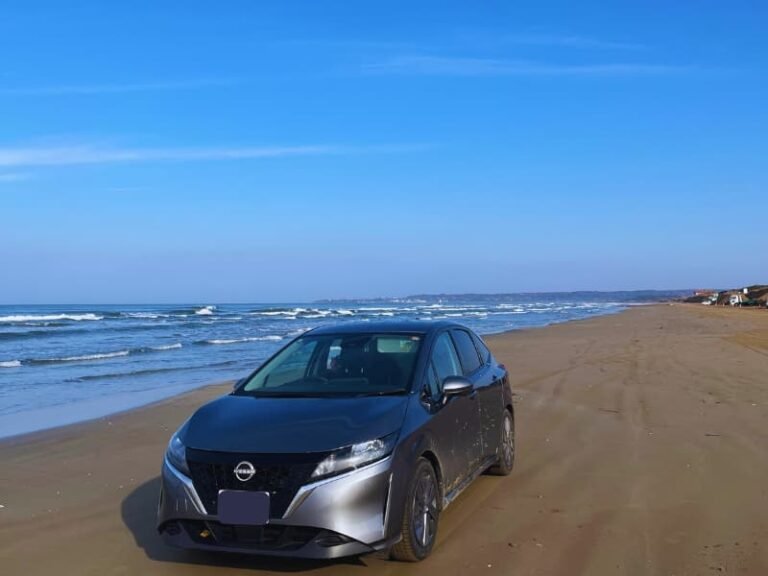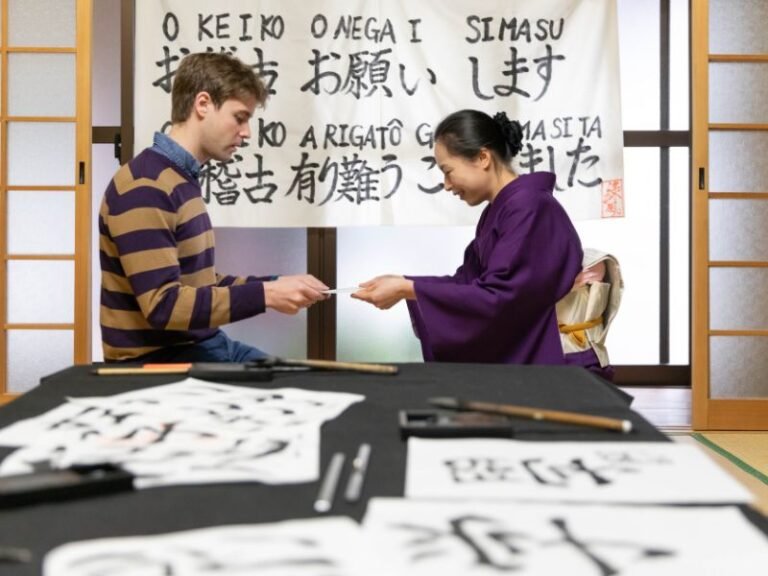Japanese Food Culture: The Complete Region-by-Region Guide
Japan is a country of incredible culinary diversity, where each region boasts its own unique flavors, traditions, and must-try dishes. From the rich miso-infused specialties of Nagoya to the fresh seafood of Hokkaido, every prefecture has something special to offer.
Having traveled to all 47 prefectures, I’ve had the chance to experience Japan’s food culture firsthand—and let me tell you, the variety is astonishing! While there are far too many amazing dishes to list, I’ve gathered some of my absolute favorites from each region to help you plan your own delicious journey through Japan.
If you’re planning a trip to Japan, this guide will introduce you to fantastic regional Japanese food you won’t want to miss. Before you finalize your itinerary, make sure to add these unforgettable food experiences!
1. Hokkaido(北海道)
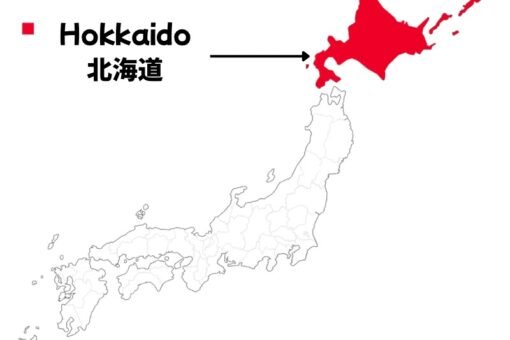
Hokkaido, Japan’s northernmost island, is a paradise for Japanese food lovers. Known for its pristine nature, cold climate, and abundant fresh ingredients, Hokkaido offers some of the best seafood, dairy products, and hearty comfort foods in the country. Whether you’re indulging in a bowl of rich miso ramen or savoring world-class chocolate, every bite in Hokkaido is an unforgettable experience.
If you’re planning a trip to Japan, Hokkaido’s food scene is a must-explore. Here are some of the region’s most iconic dishes and sweets that you won’t want to miss!
Must-Try Japanese Foods in Hokkaido
Sushi & Fresh Seafood
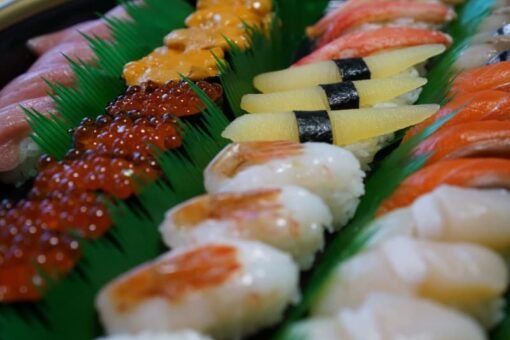
Hokkaido is famous for its exceptionally fresh seafood, thanks to the cold, nutrient-rich waters surrounding the island. Whether you’re enjoying sushi, sashimi, or seafood rice bowls, the quality is unmatched. Some must-try specialties include:
- Uni (Sea Urchin) – Creamy, rich, and incredibly fresh.
- Ikura (Salmon Roe) – Bursting with flavor and a signature topping for rice bowls.
- Crab (Kani) – Hokkaido is known for its king crab, snow crab, and hairy crab, all of which are incredibly sweet and tender.
Where to Try: Visit Nijo Market in Sapporo or Hakodate Morning Market for the freshest seafood experience.
Jingisukan (Grilled Mutton or Lamb)
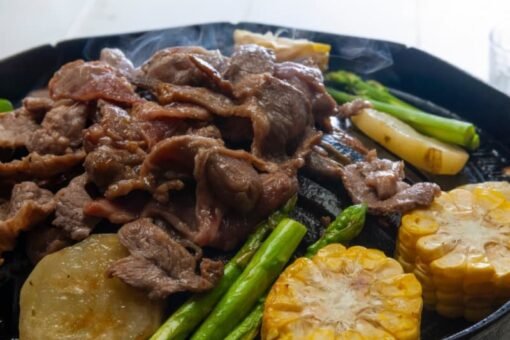
Jingisukan is Hokkaido’s signature grilled mutton or lamb dish, where thinly sliced meat is cooked alongside fresh vegetables on a special grill. The sizzling meat is then dipped into a savory sauce, creating a rich and flavorful bite.
Beyond its amazing taste, Jingisukan is a fun, social meal, best shared with friends and family over lively conversation. It’s often paired with beer—though I don’t drink, I’ve heard it’s the perfect match!
Where to Try: Visit Sapporo Beer Garden or specialty Jingisukan restaurants in Sapporo and Asahikawa.
Hokkaido-Style Ramen (Miso Ramen)
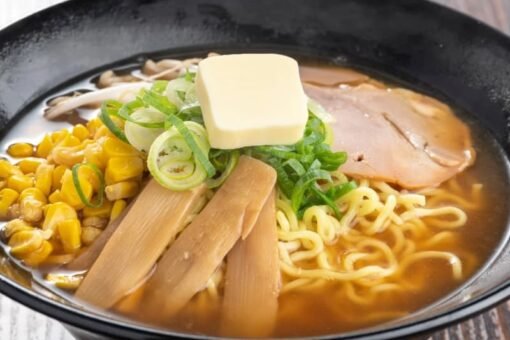
Sapporo’s miso ramen is legendary! The rich, umami-packed miso broth is deeply satisfying, and what makes it extra special is the addition of sweet corn and creamy butter—a unique Hokkaido twist. The combination of chewy noodles, hearty broth, and flavorful toppings makes this a must-try dish, especially in the colder months.
Where to Try: Visit Ramen Alley in Sapporo (ラーメン横丁)where you’ll find many famous miso ramen shops.
Soup Curry
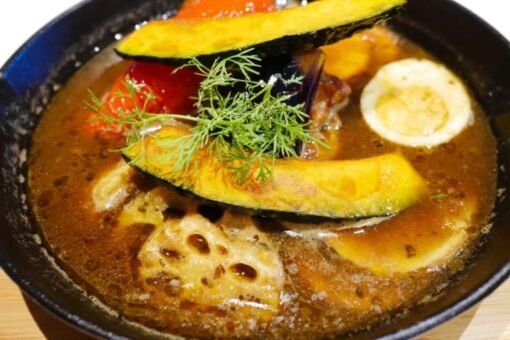
Unlike traditional Japanese curry, soup curry has a thinner, broth-like consistency—but don’t let that fool you! It’s packed with bold curry flavors and pairs beautifully with rice or bread. Loaded with tender chicken and a variety of fresh vegetables, it’s not only delicious but also a hearty and nutritious meal.
Where to Try: Visit Garaku or Suage in Sapporo, two of the most popular soup curry restaurants.
Hokkaido’s Must-Try Sweets & Snacks
Shiroi Koibito(白い恋人)
One of Hokkaido’s most famous souvenirs, Shiroi Koibito is a delicate sandwich cookie with buttery langue de chat biscuits and creamy white chocolate filling. It’s perfectly sweet and melts in your mouth—no wonder it’s a favorite across Japan!
Where to Buy: Available at Shiroi Koibito Park in Sapporo and souvenir shops across Hokkaido.
Royce Chocolate
Hokkaido’s Royce Chocolate is known for its smooth, rich texture and high-quality ingredients. Their Nama Chocolate, a soft, ganache-like chocolate dusted with cocoa powder, is especially popular.
⚠️ Caution: Royce Chocolate is delicate and should be kept under 10°C (about 50°F) to maintain its texture and flavor. If you’re traveling, make sure to eat it as soon as possible or store it in the fridge in your hotel room to prevent it from melting.
Where to Buy: Available at Royce stores in Hokkaido, New Chitose Airport, and select department stores in Japan.
Corn Chocolate by Hori
A unique Hokkaido treat, Corn Chocolate by Hori features crispy Hokkaido-grown corn coated in creamy white or milk chocolate. The combination of crunchy texture and rich chocolate makes it an addictive snack!
Where to Buy: Available at souvenir shops in Hokkaido and major airports.
2. Tohoku Region(東北地方)

The Tohoku region, located in the northeastern part of Japan’s main island, is known for its breathtaking landscapes, rich history, and warm hospitality. While it may not be as widely visited as Tokyo or Kyoto, Tohoku offers incredible local cuisine that reflects its unique culture and traditions. From hearty noodle dishes to delicious sweets, here are some must-try foods when exploring this beautiful region!
Must-Try Japanese Foods in Tohoku
Wanko Soba (Iwate)
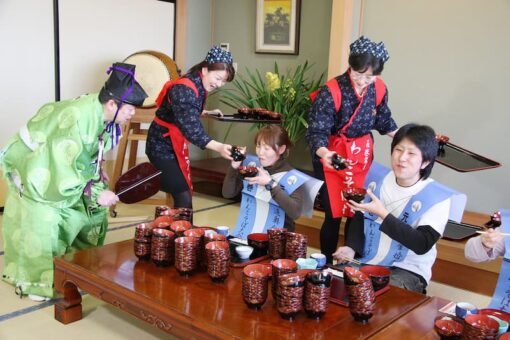
If you love soba noodles and enjoy a fun dining experience, Wanko Soba is a must-try in Iwate! This dish consists of small bowls of soba noodles served one after another, encouraging diners to eat as many as they can. It’s a lively and interactive meal, often accompanied by friendly staff cheering you on!
When I tried Wanko Soba, I managed to eat 60 bowls, but my husband took on the challenge and ate 100 bowls—earning a special Tegata, a certificate awarded to those who reach this impressive milestone! It was such a fun and memorable experience, and I highly recommend trying it if you visit Iwate.
Where to Try: Visit Azumaya, famous Wanko Soba restaurant where you can take on the challenge yourself! We visited this restaurant and did wanko soba challenge like the photo above.
Gyutan (Miyagi)
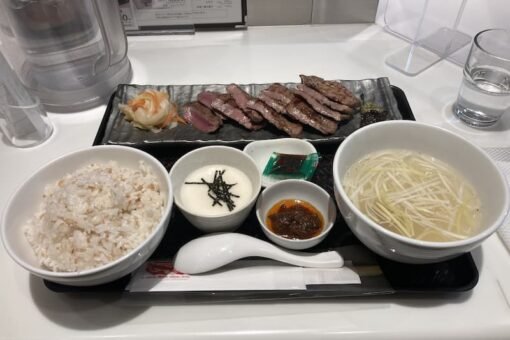
Miyagi Prefecture, especially Sendai, is famous for Gyutan, grilled beef tongue. Don’t let the name intimidate you—Gyutan is tender, flavorful, and perfectly grilled to bring out its smoky aroma. It’s often served with rice, soup, and pickled vegetables, making for a satisfying meal.
Where to Try: Visit Rikyu or Kisuke in Sendai, two well-known Gyutan specialty restaurants.
Kitakata Ramen (Fukushima)
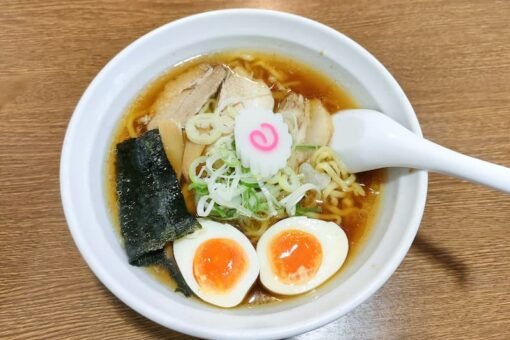
Fukushima’s Kitakata Ramen is beloved for its thick, chewy noodles and light soy-based broth. Unlike other ramen styles, Kitakata Ramen has a refreshing yet rich flavor, often topped with slices of tender pork, bamboo shoots, and green onions. If you’re a ramen lover, this is a must-try!
Asa-Ramen (朝ラー) Culture in Kitakata
One unique aspect of Kitakata Ramen is its Asa-Ramen(朝ラーメン meaning morning Ramen) culture. Many ramen shops in Kitakata open early in the morning, and locals often enjoy a steaming bowl of ramen for breakfast. The lighter, soy-based broth and chewy noodles make it surprisingly satisfying yet easy to eat in the morning.
If you’re a traveler looking for a unique food experience, trying Asa-Ramen is definitely worth it! It’s a great way to start your day like a local and enjoy Kitakata’s famous ramen in a different setting.
Where to Try: Visit Bannai Shokudo in Kitakata City, two famous ramen shops serving authentic Kitakata Ramen, including morning ramen options.
Tohoku’s Best Sweets & Snacks
Kamome no Tamago (Iwate)
A specialty from Iwate, Kamome no Tamago (meaning Seagull’s Egg) is a delightful sweet with a soft sponge cake exterior and a creamy white bean paste filling. Its smooth, slightly sweet flavor makes it a perfect souvenir or afternoon treat!
Where to Buy: You can find Kamome no Tamago at souvenir shops in Morioka Station, major department stores in Iwate, and online stores specializing in regional Japanese sweets.
Hagi no Tsuki(Miyagi)
Miyagi’s famous Hagi no Tsuki is a fluffy sponge cake filled with rich custard cream. Its soft texture and delicate sweetness make it a favorite among locals and visitors alike. If you love creamy desserts, this is a must-try!
Where to Buy: Available at Sendai Station, souvenir shops across Miyagi, and department stores in the Tohoku region. You can also find it at Sendai Airport for a last-minute treat before heading home!
Kininaru Ringo(Aomori)
Aomori’s Kininaru Ringo is a unique apple-shaped pastry made with whole baked apples wrapped in a flaky crust. The combination of sweet, juicy apple and buttery pastry creates an irresistible treat that showcases Aomori’s famous apples.
Where to Buy: You can purchase at Ragueneau Stores in Aomori, Aomori Station and Airport, Local Souvenir shops.
3. Kanto Region(関東地方)
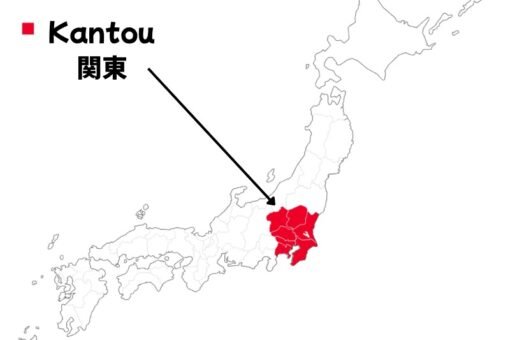
The Kanto region, home to Japan’s bustling capital, Tokyo, is a vibrant mix of modern city life and rich culinary traditions. Kanto consists of seven prefectures: Tokyo, Kanagawa, Chiba, Saitama, Gunma, Tochigi, and Ibaraki. While it’s famous for its neon-lit streets and historic landmarks, Kanto also offers an incredible variety of local dishes and sweets that reflect the region’s diverse food culture.
Must-Try Japanese Foods in Kanto
Monjayaki (Tokyo)
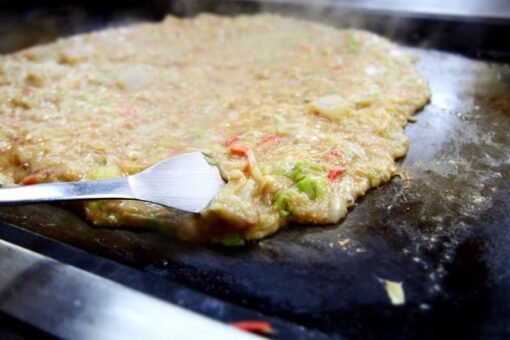
Often compared to Okonomiyaki, Monjayaki is a Tokyo specialty that features a runny mixture of ingredients like seafood, vegetables, and cheese, cooked directly on a hot griddle. As it cooks, the mixture thickens, creating a crispy, caramelized texture that’s incredibly flavorful.
The best way to enjoy Monjayaki is right off the grill, using a small spatula to scoop up the delicious bites—but be careful! It’s extremely hot, so take your time and let it cool slightly before eating to avoid burning your mouth.
Where to Try: Head to Tsukishima Monja Street in Tokyo, where you’ll find numerous restaurants specializing in Monjayaki.
Chanko Nabe (Tokyo)
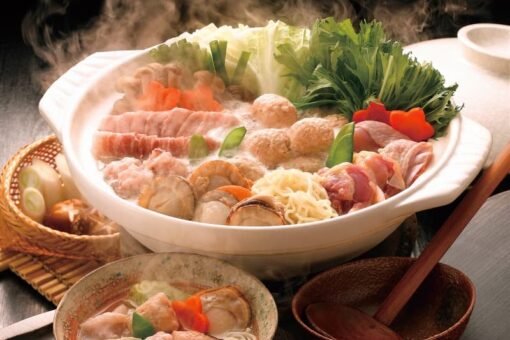
A dish deeply connected to sumo wrestling, Chanko Nabe is a hearty hot pot packed with meat, seafood, tofu, and vegetables in a flavorful broth. Traditionally eaten by sumo wrestlers to build strength, this dish is both nutritious and incredibly satisfying—perfect for warming up on a chilly day! Where to Try: Visit Ryogoku, Tokyo’s sumo district, where many restaurants serve authentic Chanko Nabe. Terao is the one of the famous restaurant owned by a retired Sumo wrestler.
Where to Try: Head to Tsukishima Monja Street in Tokyo, where you’ll find numerous restaurants specializing in Monjayaki.
Utsunomiya Gyoza (Tochigi)

Tochigi’s Utsunomiya Gyoza is famous across Japan for its juicy dumplings filled with a flavorful mix of pork, cabbage, and garlic. Whether you prefer them pan-fried, boiled, or deep-fried, Utsunomiya Gyoza is a must-try for dumpling lovers!
Where to Try: Utsunomiya City has many gyoza specialty restaurants, including the famous Utsunomiya Minmin, Utsunomiya Gyoza-kan.
Kanto’s Best Sweets & Snacks
Ningyo-yaki (Tokyo)
Ningyo-yaki are small, golden sponge cakes shaped like dolls or famous landmarks, filled with sweet red bean paste. They’re soft, slightly crispy on the outside, and make for a perfect Tokyo souvenir!
Where to Buy: You can find Ningyo-yaki at Asakusa’s Nakamise Street, near Senso-ji Temple.
Tokyo Banana (Tokyo)
One of Tokyo’s most famous souvenirs, Tokyo Banana is a soft, fluffy sponge cake filled with banana-flavored custard. Its delicate sweetness and creamy texture make it a favorite among visitors!
Where to Buy: Available at Tokyo Station, Haneda Airport, and Narita Airport, as well as major department stores.
Kurumikko (Kanagawa)
A specialty from Kanagawa, Kurumikko is a rich, nutty confection made with caramel and walnuts, sandwiched between buttery shortbread. The combination of crunchy walnuts and smooth caramel creates a perfect balance of sweetness and texture, making it a favorite among locals and visitors alike. Package is very cute!
Where to Buy: Available at Kamakura Beniya, a famous confectionery shop in Kamakura, and souvenir shops across Kanagawa.
4. Chubu area (中部地方)
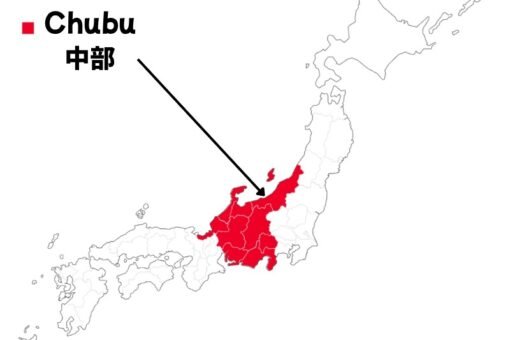
The Chubu region, located in central Japan, is a diverse area that stretches from the Japan Alps to the coastal Hokuriku region. It consists of nine prefectures: Aichi, Ishikawa, Toyama, Fukui, Gifu, Shizuoka, Yamanashi, Nagano, and Niigata. Known for its rich culinary traditions, Chubu offers everything from hearty meat dishes to fresh seafood and exquisite sweets. Whether you’re exploring the bustling streets of Nagoya or the historic town of Kanazawa, here are some must-try specialties from Chubu!
Must-Try Japanese Foods in Chubu
Miso Katsu (Aichi)
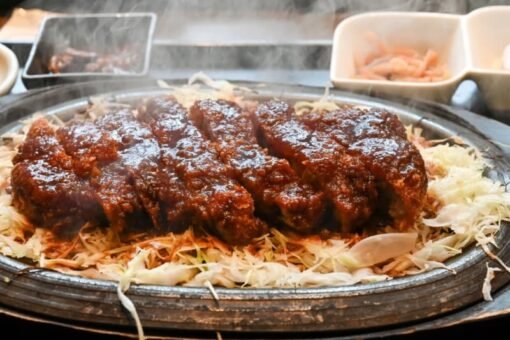
Nagoya’s take on tonkatsu (breaded pork cutlet) is Miso Katsu, a delicious twist featuring a rich, savory red miso sauce. Unlike the typical tonkatsu sauce, Nagoya’s version is deep, slightly sweet, and packed with umami, making the crispy cutlet even more flavorful.
Where to Try: Visit Yabaton, a famous Miso Katsu restaurant in Nagoya, or explore local restaurants specializing in this dish.
Seafood of Hokuriku (Ishikawa, Toyama, Fukui)

The Hokuriku region, facing the Sea of Japan, is renowned for its exceptionally fresh seafood.
Some must-try specialties include:
- Nodoguro (Blackthroat Seaperch) – A luxurious, fatty fish with a melt-in-your-mouth texture.
- Kani (Crab) – Especially popular in winter, Hokuriku’s crab is sweet and succulent.
- Toyama Bay Sushi – Featuring local catches like white shrimp and firefly squid.
Where to Try: Visit Omicho Market in Kanazawa, Shinminato Fisherman’s Wharf in Toyama for the freshest seafood experiences.
Hida Beef (Gifu)
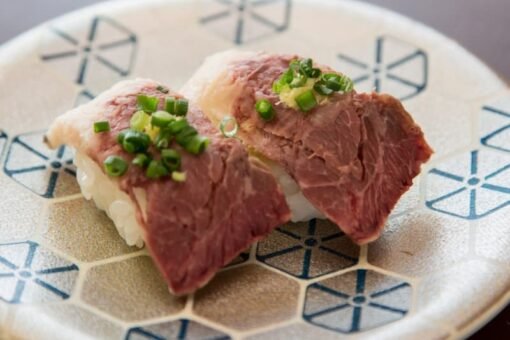
Gifu’s Hida Beef is one of Japan’s top wagyu brands, known for its intense marbling and buttery texture. Whether grilled as steak, served as sukiyaki, or enjoyed in Hoba Miso (grilled on a magnolia leaf with miso sauce), Hida Beef is a must-try for meat lovers.
One unique way to enjoy Hida Beef is Hida Gyu Sushi, where thin slices of premium beef are lightly seared and served atop sushi rice. Often topped with wasabi, soy sauce, this melt-in-your-mouth sushi is a luxurious treat that showcases the incredible quality of Hida Beef. I tried once and it was so good ! I highly recommend this sushi.
Where to Try: Head to Takayama, where many restaurants and street food stalls serve Hida Gyu Sushi, especially around Miyagawa Morning Market and Sanmachi Street(Sakaguchiya)
Chubu’s Best Sweets & Snacks
Kanazawa Gold Sweets (Ishikawa)
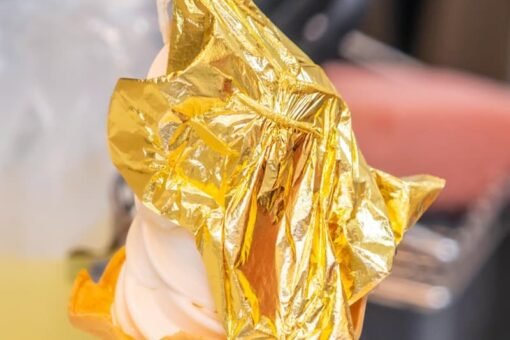
Kanazawa is famous for its gold leaf, and you’ll find stunning desserts adorned with edible gold! From gold-covered ice cream to luxurious gold-dusted wagashi (traditional sweets), these treats are as beautiful as they are delicious. You don’t worry about the taste of gold itself. It is no taste at all. Just feel geogeous!
Where to Buy: Visit Hakuichi for gold leaf soft cream! You can find many gold leaf sweets and related items at some souvenir stores in Kanazawa city.
Shingen Mochi (Yamanashi)
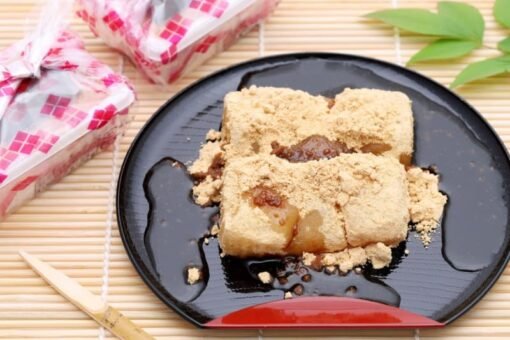
A specialty of Yamanashi, Shingen Mochi is a soft, chewy rice cake dusted with kinako (roasted soybean flour) and drizzled with sweet kuromitsu (black sugar syrup). It’s a simple yet deeply flavorful traditional sweet.
How to Eat Shingen Mochi
Shingen Mochi is typically wrapped in a small plastic sheet. To eat it properly:
- Lift the edges of the plastic sheet to create a pouch around the mochi.
- Drizzle the kuromitsu syrup over the top.
- Use chopsticks to mix the mochi and syrup gently before taking a bite.
⚠️ Be careful! The kinako powder tends to scatter everywhere, especially if you don’t follow the wrapping method. Even when handled carefully, it’s easy to make a mess—so enjoy it slowly and maybe have a napkin ready!
Where to Buy: You can find Shingen Mochi at Yamanashi souvenir shops and major train stations.
Piyorin (Aichi)
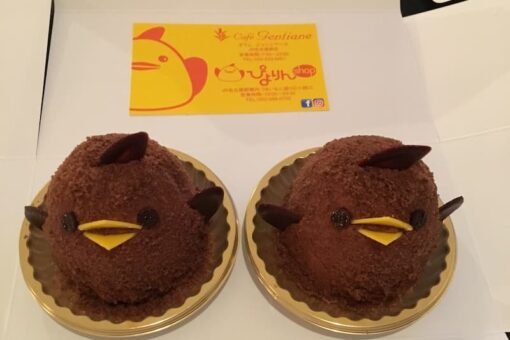
A charming and delicious treat from Nagoya, Piyorin is a chick-shaped dessert made with rich Nagoya Cochin egg pudding and fluffy sponge cake, coated in a delicate layer of caramel mousse. It’s not only adorable but also incredibly creamy and flavorful!
Piyorin Challenge
Piyorin is famously fragile, and many visitors attempt the Piyorin Challenge—trying to carry it safely without it tipping over or losing its shape before reaching their destination! Since the dessert is soft and wobbly, it requires careful handling, making the challenge a fun and memorable experience for travelers. We won this challenge! My Piyorins were fine after we came back to the hotel. (See picture above. They look good!)
Where to Buy: Available at Café Gentiane in Nagoya Station, the most famous spot to get freshly made Piyorin.
5. Kinki area (近畿地方)
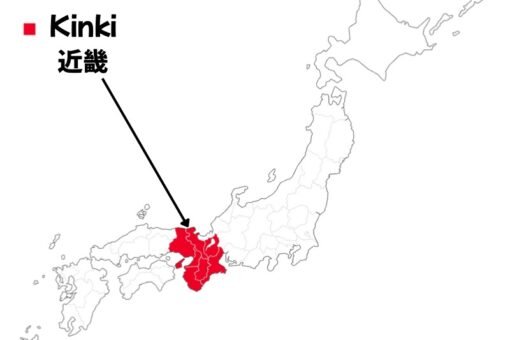
The Kinki region, located in middle-western Japan, is known for its rich history, vibrant cities, and unique food culture. It consists of seven prefectures: Osaka, Kyoto, Hyogo, Nara, Mie, Shiga, and Wakayama. Kinki is often considered the heart of Japanese cuisine, offering everything from savory street food to elegant sweets. Whether you’re strolling through the bustling streets of Osaka or exploring Kyoto’s traditional tea houses, here are some must-try specialties from Kinki!
Must-Try Foods in Kinki
Takoyaki (Osaka)
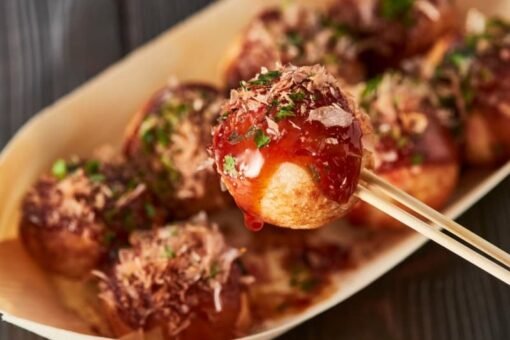
Osaka is famous for Takoyaki, delicious bite-sized balls made from a batter filled with octopus, green onions, and tempura bits. Cooked on a special griddle, they’re crispy on the outside and soft on the inside. Takoyaki is typically topped with savory sauce, mayonnaise, bonito flakes, and seaweed powder, making it a flavorful and addictive street food!
⚠️ Caution: Even if Takoyaki looks cool on the outside, the inside is extremely hot! I recommend not eating it in one bite—instead, take small bites or let it cool slightly to avoid burning your mouth.
Where to Try: Visit Dotonbori in Osaka, where you’ll find many Takoyaki stalls serving fresh, piping-hot Takoyaki.
Okonomiyaki (Osaka)

Another Osaka specialty, Okonomiyaki is a savory pancake made with flour, eggs, shredded cabbage, and various toppings like pork, seafood, or cheese. It’s cooked on a hot griddle and topped with Okonomiyaki sauce, mayo, bonito flakes(Katsuobushi 鰹節), and seaweed (Nori (海苔)) powder. Some restaurants even let you cook it yourself, making it a fun and interactive dining experience!
Where to Try: Head to Umeda or Dotonbori, where many restaurants specialize in Okonomiyaki.
Kobe & Matsusaka Beef (Hyogo & Mie)
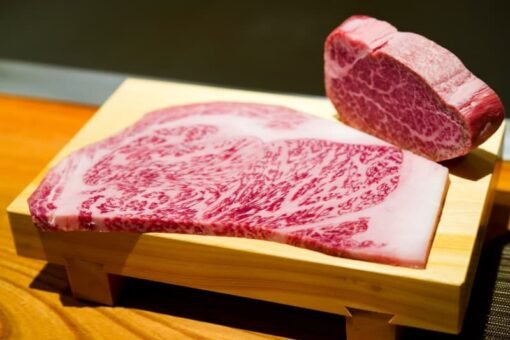
Kinki area is home to two of Japan’s most famous wagyu brands:
- Kobe Beef (Hyogo) – Known for its intense marbling and melt-in-your-mouth texture, Kobe Beef is one of the most luxurious meats in the world.
- Matsusaka Beef (Mie) – Often considered one of Japan’s top wagyu varieties, Matsusaka Beef is incredibly tender and rich in flavor, perfect for steak or sukiyaki.
Where to Try: Visit Kobe’s steak houses for authentic Kobe Beef or head to Matsusaka City in Mie for premium Matsusaka Beef dishes.
Kinki’s Best Sweets & Snacks
Matcha Parfait (Kyoto)
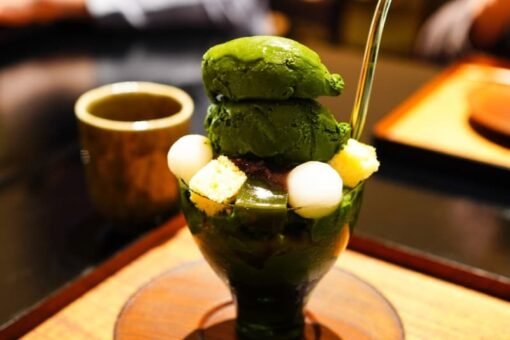
Kyoto is famous for its high-quality matcha, and one of the best ways to enjoy it is in a Matcha Parfait! This elegant dessert features layers of matcha ice cream, mochi, red bean paste, whipped cream, and crispy wafers, creating a perfect balance of flavors and textures.
Where to Buy: Available at Kyoto’s traditional tea houses and dessert cafés, especially in Gion and Uji.
Mitarashi Dango (Kyoto)
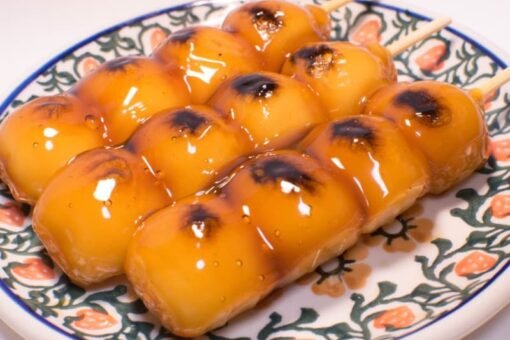
Mitarashi Dango are skewered rice dumplings coated in a sweet soy glaze, giving them a slightly caramelized, smoky flavor. They’re soft, chewy, and perfect for a quick snack while exploring Kyoto’s historic streets.
Where to Buy: You can find Mitarashi Dango at street stalls in Kyoto, especially around Fushimi Inari Shrine and Kiyomizu-dera Temple.
Yatsuhashi (Kyoto)
A classic Kyoto souvenir, Yatsuhashi is a delicate sweet made from cinnamon-flavored rice flour. It comes in two varieties:
- Baked Yatsuhashi – Crispy and cookie-like.
- Nama Yatsuhashi – Soft and chewy, often filled with red bean paste or matcha cream.
Where to Buy: Available at Kyoto Station, souvenir shops, and traditional confectionery stores throughout Kyoto.
6. Chugoku and Shikoku area (中国・四国地方)
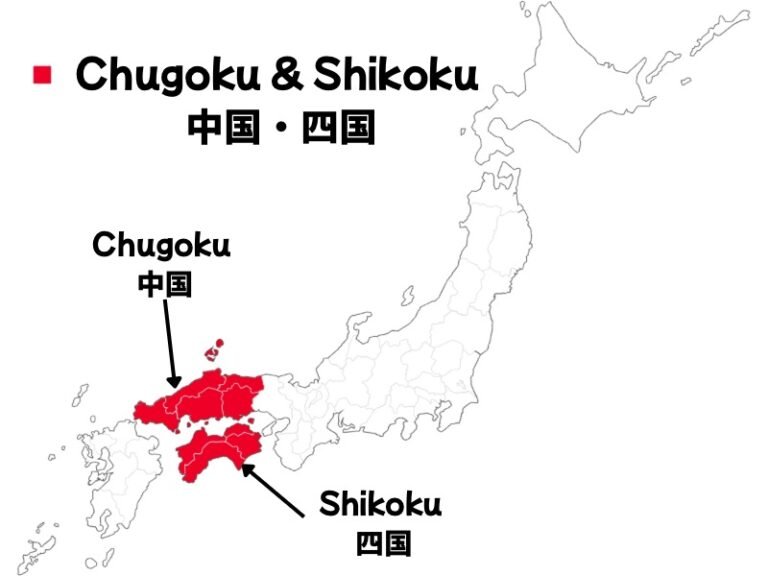
The Chugoku and Shikoku regions, located in western Japan, are known for their stunning coastal landscapes, rich history, and unique local cuisine.
- Chugoku consists of Hiroshima, Okayama, Shimane, Tottori, and Yamaguchi and is famous for its seafood, hearty dishes, and historical sites like Hiroshima’s Peace Memorial Park.
- Shikoku includes Kagawa, Ehime, Tokushima, and Kochi, offering incredible noodle dishes, fresh seafood, and a deep-rooted culture of hospitality.
From Hiroshima’s savory pancakes to Kochi’s flame-seared tuna, here are some must-try specialties from these regions!
Must-Try Japanese Foods in Chugoku & Shikoku
Hiroshimayaki (Hiroshima)
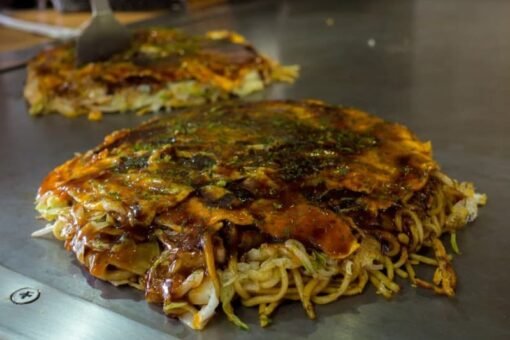
Hiroshimayaki, or Hiroshima-style Okonomiyaki, is a layered version of Japan’s famous savory pancake. Unlike the Osaka-style mix, Hiroshimayaki features thin layers of batter, cabbage, pork, and yakisoba noodles, all topped with a rich okonomiyaki sauce, mayonnaise, and bonito flakes. The result is a crispy, flavorful dish with a satisfying texture!
Where to Try: Visit Okonomimura in Hiroshima, a building filled with Okonomiyaki specialty restaurants.
Sanuki Udon (Kagawa)
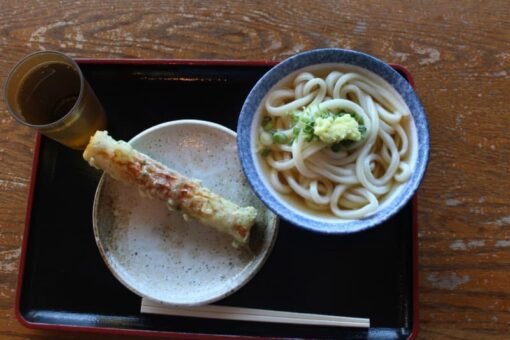
Kagawa is known as “Udon Prefecture”, and its Sanuki Udon is one of Japan’s most famous udon varieties. Characterized by thick, chewy noodles and a light, flavorful broth, Sanuki Udon is simple yet incredibly satisfying. It’s often served with tempura, green onions, and a splash of soy sauce.
One of the best things about eating udon in Kagawa is the abundance of small, local udon restaurants scattered throughout the prefecture. Many of these shops have a warm, welcoming atmosphere, allowing you to enjoy freshly made udon just like the locals do. It’s a truly authentic experience that makes the meal even more special!
Where to Try: Visit Takamatsu City, where you’ll find countless udon shops serving freshly made noodles.
Katsuo no Tataki (Kochi)
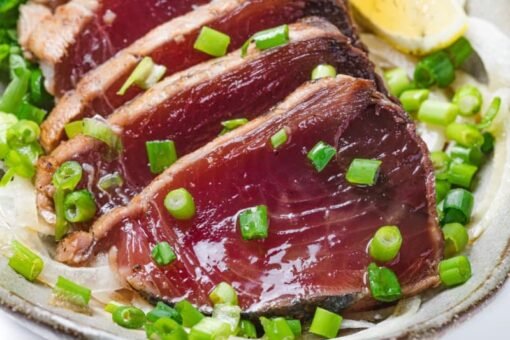
Kochi’s Katsuo no Tataki is a unique way of preparing bonito (skipjack tuna). The fish is lightly seared over an open flame, giving it a smoky aroma while keeping the inside tender and fresh. It’s typically served with garlic, green onions, and ponzu sauce, creating a refreshing and flavorful dish.
Where to Try: Visit Hirome Market in Kochi, where you can enjoy freshly made Katsuo no Tataki.
Chugoku & Shikoku’s Best Sweets & Snacks
Momiji Manju (Hiroshima)
A beloved Hiroshima souvenir, Momiji Manju is a maple leaf-shaped sponge cake filled with sweet red bean paste, custard, or matcha cream. Soft, fluffy, and slightly sweet, it’s a perfect treat to enjoy with tea.
Where to Buy: Available at Miyajima Island and souvenir shops in Hiroshima.
Kibidango (Okayama)
Inspired by the famous Momotaro legend, Kibidango are soft, chewy rice flour dumplings with a delicate sweetness. Traditionally made with millet flour, they have a slightly nutty flavor and are often enjoyed as a nostalgic treat.
According to the Momotaro folktale, a boy named Momotaro was born from a peach and set off on a journey to defeat evil ogres. Along the way, he shared Kibidango with a dog, monkey, and pheasant, who became his loyal companions. Because of this story, Kibidango is often associated with friendship and adventure!
Where to Buy: Available at Okayama Station and souvenir shops across Okayama Prefecture.
Ichiroku Tart (Ehime)
Ehime’s Ichiroku Tart is a rolled sponge cake filled with sweet red bean paste and yuzu-flavored cream, creating a perfect balance of citrusy freshness and sweetness. It’s light, fluffy, and a great souvenir from Shikoku!
Where to Buy: Available at Matsuyama Station and confectionery shops in
7. Kyushu and Okinawa area (九州・沖縄地方)

The Kyushu & Okinawa regions, located in southern Japan, are known for their warm climate, rich history, and incredible food culture.
- Kyushu consists of Fukuoka, Saga, Nagasaki, Kumamoto, Oita, Miyazaki, and Kagoshima and is famous for its ramen, fresh seafood, and unique regional specialties.
- Okinawa, Japan’s southernmost prefecture, has a distinct food culture influenced by China US and Southeast Asia, offering healthy, flavorful dishes with tropical ingredients.
From Nagasaki’s unique noodle dishes to Okinawa’s vibrant stir-fries, here are some must-try specialties from these regions!
Must-Try Japanese Foods in Kyushu and Okinawa
Champon Noodles (Nagasaki)
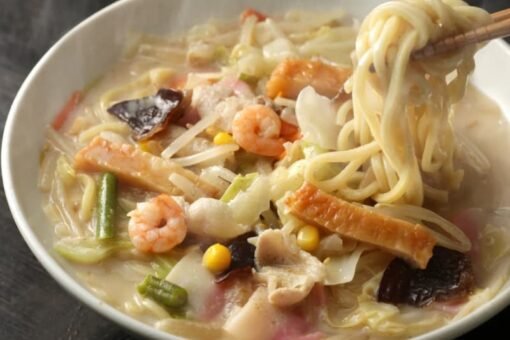
Nagasaki’s Champon is a comforting noodle dish featuring a rich, creamy broth made from pork and chicken, topped with a generous mix of seafood, vegetables, and meat. Unlike other noodle dishes, Champon uses thicker, chewy noodles, making it a satisfying meal that reflects Nagasaki’s multicultural influences.
Where to Try: Visit Shikairou, one of Nagasaki’s most famous Champon restaurants.
Yobuko Ika (Saga)
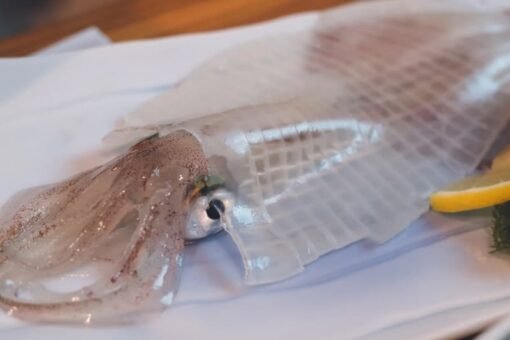
Saga’s Yobuko Ika (squid) is famous for its exceptional freshness and transparency. Served as sashimi, the squid is so fresh that it remains translucent, offering a delicate sweetness and smooth texture. After enjoying the sashimi, the remaining squid is often grilled or deep-fried, making for a complete seafood experience!
Where to Try: Visit Kawataro , where you can enjoy freshly prepared Yobuko Ika. I visited once and it was so nice!!
Goya Champuru (Okinawa)

A staple of Okinawan cuisine, Goya Champuru is a stir-fry made with bitter melon (goya), tofu, pork, and eggs. The bitterness of the goya is balanced by the richness of the other ingredients, creating a healthy and flavorful dish that reflects Okinawa’s focus on longevity and nutrition.
Where to Try: Available at local Okinawan restaurants, especially in Naha.
Kyushu & Okinawa’s Best Sweets & Snacks
Ikinari Dango (Kumamoto)
Ikinari Dango is a simple yet delicious Kumamoto sweet made with steamed sweet potato and red bean paste wrapped in a chewy flour dough. The combination of earthy sweetness and soft texture makes it a comforting treat.
Where to Buy: Available at traditional confectionery stores in Kumamoto
Castella (Nagasaki)
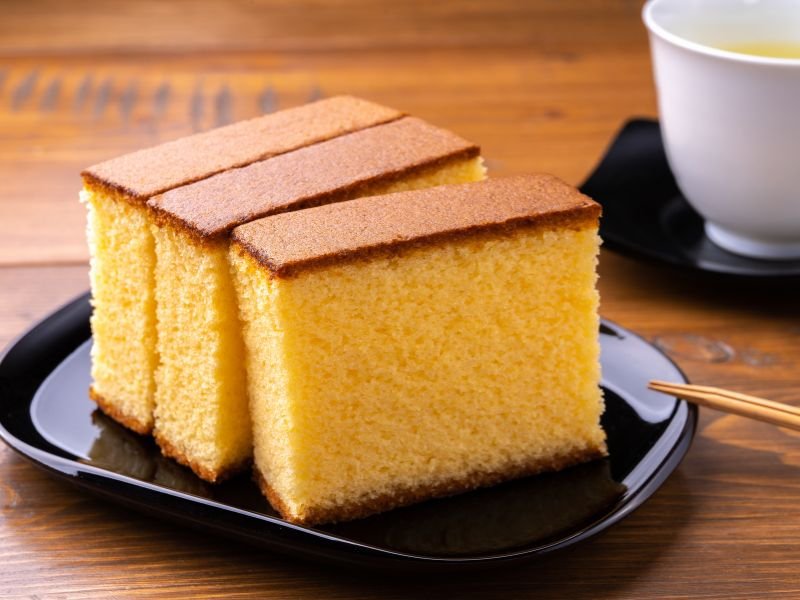
Originally introduced by Portuguese traders, Castella is a soft, fluffy sponge cake with a delicate sweetness. Made with simple ingredients like eggs, sugar, and flour, Castella has a rich history and remains one of Nagasaki’s most famous souvenirs.
Where to Buy: Available at Fukusaya and Bunmeido, two of Nagasaki’s most famous Castella shops.
Shirokuma (Kagoshima)
Shirokuma is a refreshing Kagoshima dessert featuring shaved ice topped with condensed milk, colorful fruits, and sweet red beans. It’s perfect for cooling down in the warm southern climate and has a fun, playful presentation! Where to Buy: Available at Tenmonkan Mujaki, the birthplace of Shirokuma in Kagoshima.
Conclusion
From Hokkaido’s fresh seafood to Okinawa’s tropical flavors, every region in Japan offers something uniquely delicious. Whether you’re planning your itinerary or already have your travel dates set, I hope this guide helps you discover what to eat and where to find truly authentic regional Japanese food.
Which region are you most excited to eat your way through? Let me know in the comments! And if you found this guide helpful, please share it with your fellow travelers.
